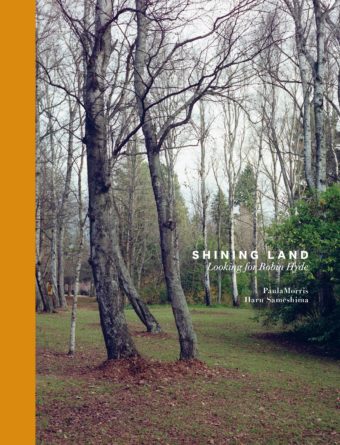Shining Land is the second title in Massey University Press’s enterprising kōrero series. The series presents itself as picture books for grown-ups, which goes some way to accounting for this volume’s appeal: like the best picture books, Shining Land is short and physically beautiful; the narrative and the images are inseparable and entirely complementary; it’s a book to read in a single sitting, and return to. And, like the best picture books, it opens up vistas well beyond its relatively modest scale.
This volume pairs the novelist, short story writer and essayist Paula Morris with the photographer Haru Sameshima; Gary Stewart’s indispensable design sensibility is the third strand in this ravishing production. The topic of the kōrero – the conversation between two kinds of artistic intelligence that the series invites – is Robin Hyde, journalist, novelist, poet. Hyde’s life has been well documented by herself and others, so what new insights might this conversation offer? It touches on familiar aspects of her story: her family, her professional life, her prickly relationship with the literary blokes of her day, two children born ‘out of wedlock’, the Robin/Iris personae, her physical and psychic wounds, the constant movement, the sad end. The themes are familiar, too: the effect of war on men of Hyde’s generation; her insight that women’s ‘unthinking hero-worship’ of the soldier in uniform underscores toxic gender relations; the cost, to women, of sexual activity outside marriage.
The fresh insights arrive courtesy of a three-way dynamic: thanks to Morris’s meticulous scholarship and Sameshima’s visual empathy, Hyde is herself an active if ghostly participant in the conversation. Morris has contrived a singularly fitting narrative arc for this picture book: she and her husband embark on a road trip through Hyde’s New Zealand – at least, the North Island parts, the parts accessible in the urgent days before COVID-19 confined us to our own virtual attics. Haru, in quarantine, will make his own journey separately. Paula and Tom visit Rotorua, where Iris met Frederick de Mulford Hyde – Haru’s image of an unmade bed in a ‘snug room’ in the Prince’s Gate Hotel captures a seedy glamour, but even more, the claustrophobia of Hyde’s failed dream of sexual autonomy. A second Rotorua image, of an abandoned thermal bath, introduces a key visual metaphor. Do the steps lead up or down? The affair leaves Iris pregnant; she moves to Sydney to have the baby, who does not survive. Haru visits Porirua Mental Hospital and Queen Mary Hospital in Hanmer Springs; Paula and Tom move on to Whanganui, and more stairs – to Hyde’s second-floor room on Somme Parade (‘lest we forget’, as Morris wryly notes), and to the offices of the Wanganui Chronicle, where Hyde worked briefly, until another affair led to another pregnancy. Hyde hides on D’Urville Island; her son Derek is born in Picton. There’s no future for her in Whanganui; Paula and Haru follow her to Auckland, to what was once Avondale Mental Hospital. Here are the most telling stairs of all – the steep, narrow staircase leading to Hyde’s attic refuge in the Grey Lodge. The photographer leans over the banister. Two flights pivot around the handrail directly below him. One flight appears to lead down; the other, up toward the light. Morris reminds us that Hyde’s limp would have it made it especially difficult for her to negotiate that narrow stairway.
As any reader of picture books knows, a journey of discovery will inevitably uncover as much about the seekers as the sought: for me, the book’s most telling moments are those where Morris’s family story, Sameshima’s images, and the world Hyde knew, touch most closely – Morris’s memory of visiting Auckland War Memorial Museum as a child, and her English grandfather’s silence about his experience in France; Hyde’s Uncle Bertie’s unmarked grave at Gallipoli; Sameshima’s image of a frieze on the Royal Artillery Memorial in Hyde Park Corner – the ‘overseas’ that drew the sons of Empire to their deaths, and Paula, Iris and Haru towards their own futures. Each has a slightly attenuated connection to this place: Hyde was born in South Africa, lived in New Zealand for thirty years, and died in London. Paula is tangata whenua, fairly recently returned to New Zealand after thirty years away: she says she tried to make homes in nine cities in those years. Haru, born in Japan, moved to New Zealand in 1973. They share that experience of dislocation, of precariousness, of feeling foreign. Hyde failed to find a home in this world; Paula rarely visits her father’s papakāinga at Pakiri: this contested land, she says, feels too heavy with history. Haru’s frontispiece encapsulates the book’s elegiac tone: a rainbow – Iris of the ancient Greeks – glimmers on the horizon beyond the sea cliffs at Irimahuwhero on the West Coast, not far south of where the godwits leave on their own immemorial journey.
This review was originally published on the Academy of NZ Literature site.



